Principles of Management and Leadership - CMI 301 Assignment Booklet
VerifiedAdded on 2023/01/13
|18
|5395
|1
Homework Assignment
AI Summary
This CMI 301 assessment booklet, focusing on the principles of management and leadership, requires students to demonstrate understanding across various organizational aspects. The assignment begins with an exploration of organizational governance, requiring students to differentiate between organization types such as sole traders, public sectors, and public limited companies, detailing the governance structures of each. Task 2 delves into how organizations operate, examining the factors influencing organizational culture, the purpose of mission, vision, and value statements, and the role of organizational strategies. Finally, task 3 focuses on the role of a manager within an organization, summarizing their responsibilities and contributions. The assignment emphasizes the application of theoretical concepts to real-world scenarios, encouraging the use of examples from known organizations to illustrate key principles. The assessment adheres to CMI guidelines, including word count and referencing standards.
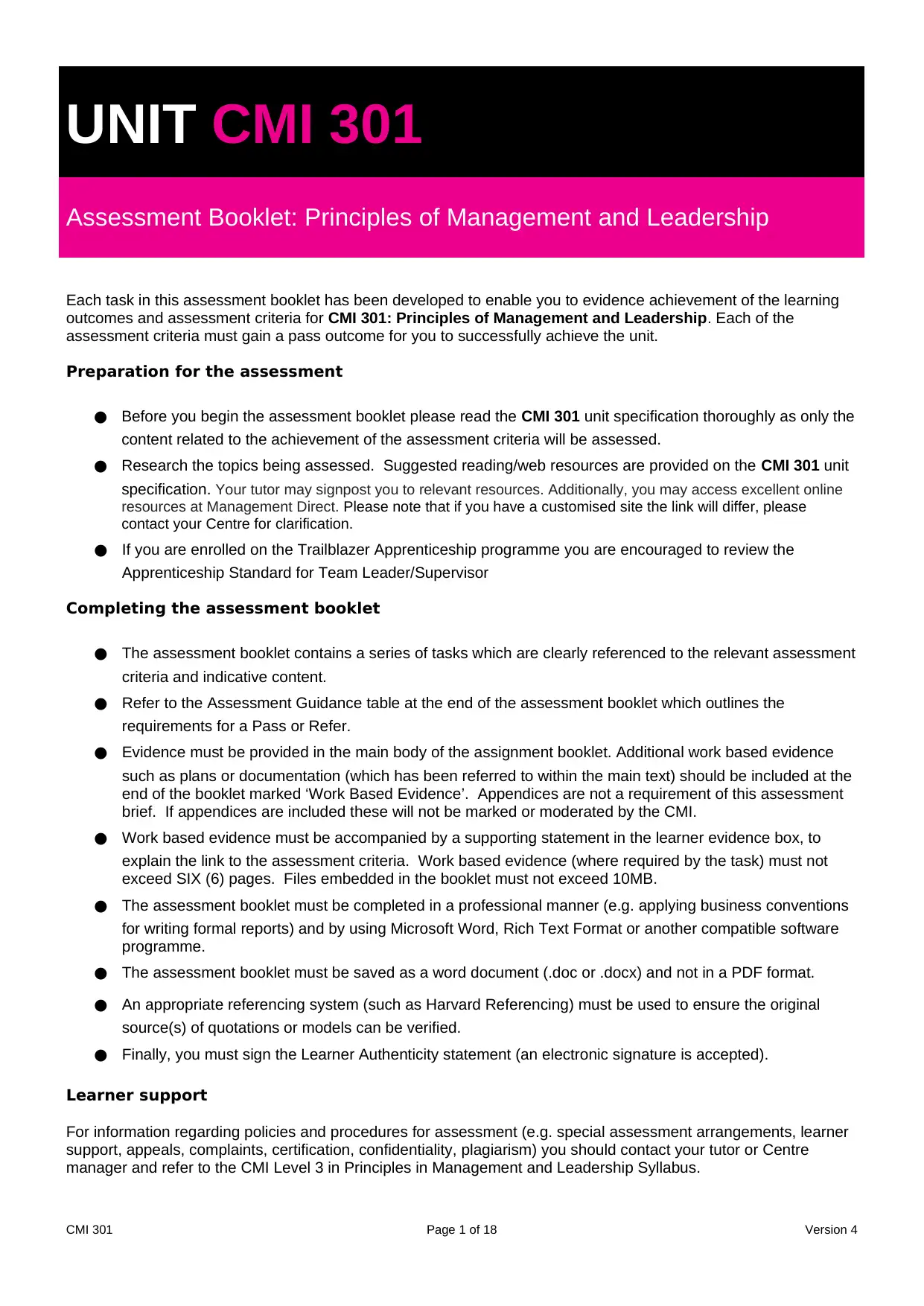
UNIT CMI 301
Assessment Booklet: Principles of Management and Leadership
Each task in this assessment booklet has been developed to enable you to evidence achievement of the learning
outcomes and assessment criteria for CMI 301: Principles of Management and Leadership. Each of the
assessment criteria must gain a pass outcome for you to successfully achieve the unit.
Preparation for the assessment
● Before you begin the assessment booklet please read the CMI 301 unit specification thoroughly as only the
content related to the achievement of the assessment criteria will be assessed.
● Research the topics being assessed. Suggested reading/web resources are provided on the CMI 301 unit
specification. Your tutor may signpost you to relevant resources. Additionally, you may access excellent online
resources at Management Direct. Please note that if you have a customised site the link will differ, please
contact your Centre for clarification.
● If you are enrolled on the Trailblazer Apprenticeship programme you are encouraged to review the
Apprenticeship Standard for Team Leader/Supervisor
Completing the assessment booklet
● The assessment booklet contains a series of tasks which are clearly referenced to the relevant assessment
criteria and indicative content.
● Refer to the Assessment Guidance table at the end of the assessment booklet which outlines the
requirements for a Pass or Refer.
● Evidence must be provided in the main body of the assignment booklet. Additional work based evidence
such as plans or documentation (which has been referred to within the main text) should be included at the
end of the booklet marked ‘Work Based Evidence’. Appendices are not a requirement of this assessment
brief. If appendices are included these will not be marked or moderated by the CMI.
● Work based evidence must be accompanied by a supporting statement in the learner evidence box, to
explain the link to the assessment criteria. Work based evidence (where required by the task) must not
exceed SIX (6) pages. Files embedded in the booklet must not exceed 10MB.
● The assessment booklet must be completed in a professional manner (e.g. applying business conventions
for writing formal reports) and by using Microsoft Word, Rich Text Format or another compatible software
programme.
● The assessment booklet must be saved as a word document (.doc or .docx) and not in a PDF format.
● An appropriate referencing system (such as Harvard Referencing) must be used to ensure the original
source(s) of quotations or models can be verified.
● Finally, you must sign the Learner Authenticity statement (an electronic signature is accepted).
Learner support
For information regarding policies and procedures for assessment (e.g. special assessment arrangements, learner
support, appeals, complaints, certification, confidentiality, plagiarism) you should contact your tutor or Centre
manager and refer to the CMI Level 3 in Principles in Management and Leadership Syllabus.
CMI 301 Page 1 of 18 Version 4
Assessment Booklet: Principles of Management and Leadership
Each task in this assessment booklet has been developed to enable you to evidence achievement of the learning
outcomes and assessment criteria for CMI 301: Principles of Management and Leadership. Each of the
assessment criteria must gain a pass outcome for you to successfully achieve the unit.
Preparation for the assessment
● Before you begin the assessment booklet please read the CMI 301 unit specification thoroughly as only the
content related to the achievement of the assessment criteria will be assessed.
● Research the topics being assessed. Suggested reading/web resources are provided on the CMI 301 unit
specification. Your tutor may signpost you to relevant resources. Additionally, you may access excellent online
resources at Management Direct. Please note that if you have a customised site the link will differ, please
contact your Centre for clarification.
● If you are enrolled on the Trailblazer Apprenticeship programme you are encouraged to review the
Apprenticeship Standard for Team Leader/Supervisor
Completing the assessment booklet
● The assessment booklet contains a series of tasks which are clearly referenced to the relevant assessment
criteria and indicative content.
● Refer to the Assessment Guidance table at the end of the assessment booklet which outlines the
requirements for a Pass or Refer.
● Evidence must be provided in the main body of the assignment booklet. Additional work based evidence
such as plans or documentation (which has been referred to within the main text) should be included at the
end of the booklet marked ‘Work Based Evidence’. Appendices are not a requirement of this assessment
brief. If appendices are included these will not be marked or moderated by the CMI.
● Work based evidence must be accompanied by a supporting statement in the learner evidence box, to
explain the link to the assessment criteria. Work based evidence (where required by the task) must not
exceed SIX (6) pages. Files embedded in the booklet must not exceed 10MB.
● The assessment booklet must be completed in a professional manner (e.g. applying business conventions
for writing formal reports) and by using Microsoft Word, Rich Text Format or another compatible software
programme.
● The assessment booklet must be saved as a word document (.doc or .docx) and not in a PDF format.
● An appropriate referencing system (such as Harvard Referencing) must be used to ensure the original
source(s) of quotations or models can be verified.
● Finally, you must sign the Learner Authenticity statement (an electronic signature is accepted).
Learner support
For information regarding policies and procedures for assessment (e.g. special assessment arrangements, learner
support, appeals, complaints, certification, confidentiality, plagiarism) you should contact your tutor or Centre
manager and refer to the CMI Level 3 in Principles in Management and Leadership Syllabus.
CMI 301 Page 1 of 18 Version 4
Paraphrase This Document
Need a fresh take? Get an instant paraphrase of this document with our AI Paraphraser
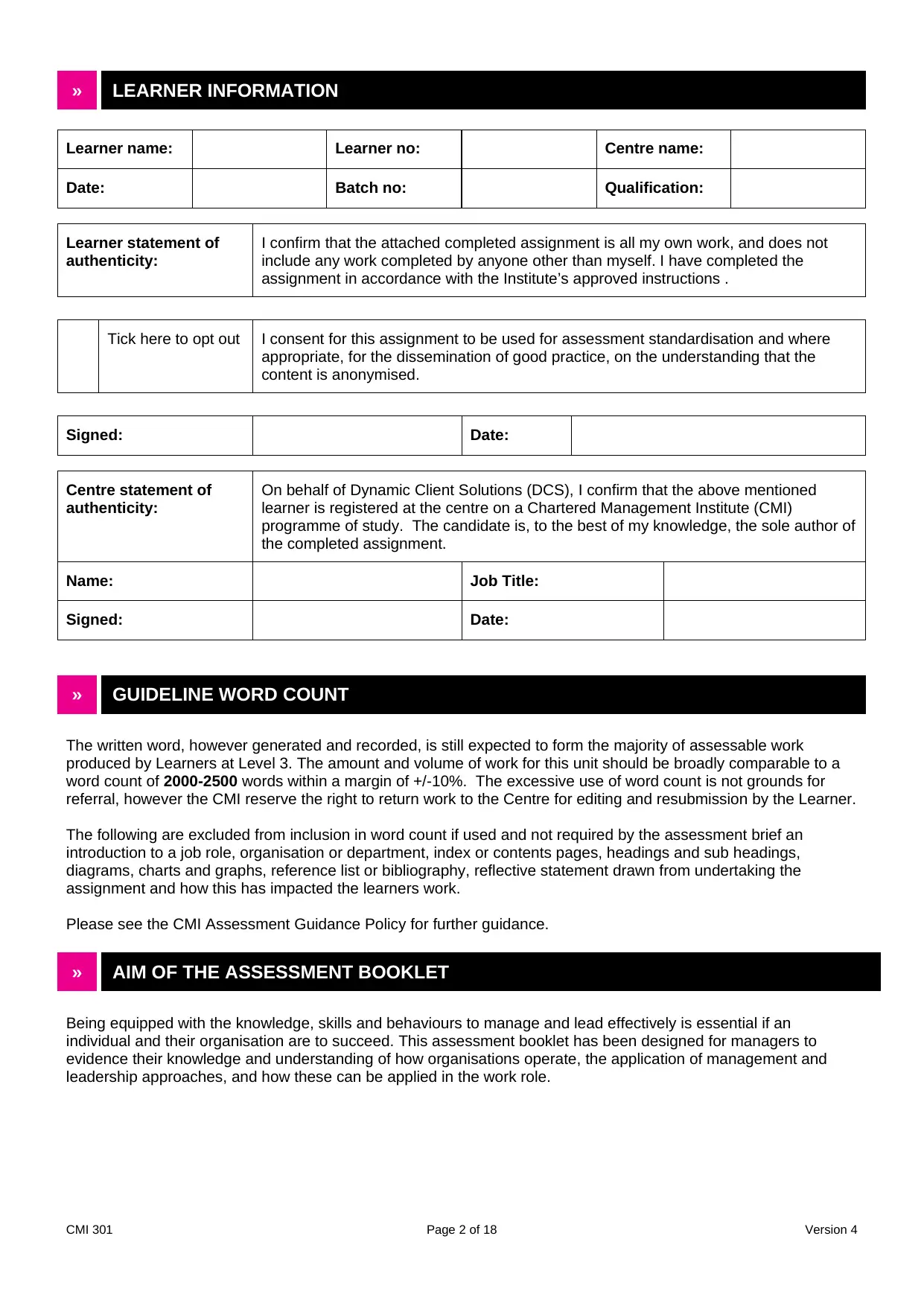
» LEARNER INFORMATION
Learner name: Learner no: Centre name:
Date: Batch no: Qualification:
Learner statement of
authenticity:
I confirm that the attached completed assignment is all my own work, and does not
include any work completed by anyone other than myself. I have completed the
assignment in accordance with the Institute’s approved instructions .
Tick here to opt out I consent for this assignment to be used for assessment standardisation and where
appropriate, for the dissemination of good practice, on the understanding that the
content is anonymised.
Signed: Date:
Centre statement of
authenticity:
On behalf of Dynamic Client Solutions (DCS), I confirm that the above mentioned
learner is registered at the centre on a Chartered Management Institute (CMI)
programme of study. The candidate is, to the best of my knowledge, the sole author of
the completed assignment.
Name: Job Title:
Signed: Date:
» GUIDELINE WORD COUNT
The written word, however generated and recorded, is still expected to form the majority of assessable work
produced by Learners at Level 3. The amount and volume of work for this unit should be broadly comparable to a
word count of 2000-2500 words within a margin of +/-10%. The excessive use of word count is not grounds for
referral, however the CMI reserve the right to return work to the Centre for editing and resubmission by the Learner.
The following are excluded from inclusion in word count if used and not required by the assessment brief an
introduction to a job role, organisation or department, index or contents pages, headings and sub headings,
diagrams, charts and graphs, reference list or bibliography, reflective statement drawn from undertaking the
assignment and how this has impacted the learners work.
Please see the CMI Assessment Guidance Policy for further guidance.
» AIM OF THE ASSESSMENT BOOKLET
Being equipped with the knowledge, skills and behaviours to manage and lead effectively is essential if an
individual and their organisation are to succeed. This assessment booklet has been designed for managers to
evidence their knowledge and understanding of how organisations operate, the application of management and
leadership approaches, and how these can be applied in the work role.
CMI 301 Page 2 of 18 Version 4
Learner name: Learner no: Centre name:
Date: Batch no: Qualification:
Learner statement of
authenticity:
I confirm that the attached completed assignment is all my own work, and does not
include any work completed by anyone other than myself. I have completed the
assignment in accordance with the Institute’s approved instructions .
Tick here to opt out I consent for this assignment to be used for assessment standardisation and where
appropriate, for the dissemination of good practice, on the understanding that the
content is anonymised.
Signed: Date:
Centre statement of
authenticity:
On behalf of Dynamic Client Solutions (DCS), I confirm that the above mentioned
learner is registered at the centre on a Chartered Management Institute (CMI)
programme of study. The candidate is, to the best of my knowledge, the sole author of
the completed assignment.
Name: Job Title:
Signed: Date:
» GUIDELINE WORD COUNT
The written word, however generated and recorded, is still expected to form the majority of assessable work
produced by Learners at Level 3. The amount and volume of work for this unit should be broadly comparable to a
word count of 2000-2500 words within a margin of +/-10%. The excessive use of word count is not grounds for
referral, however the CMI reserve the right to return work to the Centre for editing and resubmission by the Learner.
The following are excluded from inclusion in word count if used and not required by the assessment brief an
introduction to a job role, organisation or department, index or contents pages, headings and sub headings,
diagrams, charts and graphs, reference list or bibliography, reflective statement drawn from undertaking the
assignment and how this has impacted the learners work.
Please see the CMI Assessment Guidance Policy for further guidance.
» AIM OF THE ASSESSMENT BOOKLET
Being equipped with the knowledge, skills and behaviours to manage and lead effectively is essential if an
individual and their organisation are to succeed. This assessment booklet has been designed for managers to
evidence their knowledge and understanding of how organisations operate, the application of management and
leadership approaches, and how these can be applied in the work role.
CMI 301 Page 2 of 18 Version 4
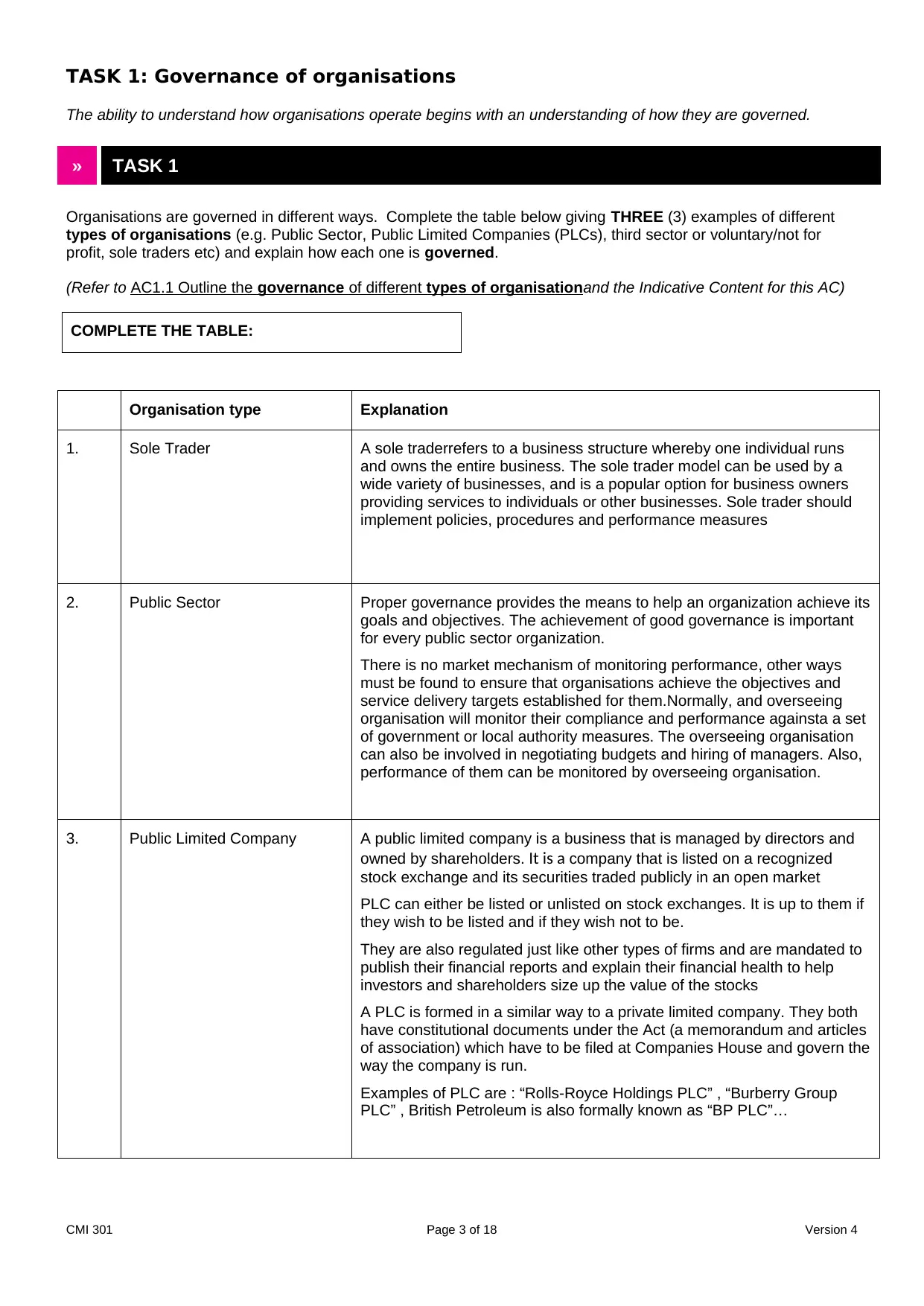
TASK 1: Governance of organisations
The ability to understand how organisations operate begins with an understanding of how they are governed.
» TASK 1
Organisations are governed in different ways. Complete the table below giving THREE (3) examples of different
types of organisations (e.g. Public Sector, Public Limited Companies (PLCs), third sector or voluntary/not for
profit, sole traders etc) and explain how each one is governed.
(Refer to AC1.1 Outline the governance of different types of organisationand the Indicative Content for this AC)
COMPLETE THE TABLE:
Organisation type Explanation
1. Sole Trader A sole traderrefers to a business structure whereby one individual runs
and owns the entire business. The sole trader model can be used by a
wide variety of businesses, and is a popular option for business owners
providing services to individuals or other businesses. Sole trader should
implement policies, procedures and performance measures
2. Public Sector Proper governance provides the means to help an organization achieve its
goals and objectives. The achievement of good governance is important
for every public sector organization.
There is no market mechanism of monitoring performance, other ways
must be found to ensure that organisations achieve the objectives and
service delivery targets established for them.Normally, and overseeing
organisation will monitor their compliance and performance againsta a set
of government or local authority measures. The overseeing organisation
can also be involved in negotiating budgets and hiring of managers. Also,
performance of them can be monitored by overseeing organisation.
3. Public Limited Company A public limited company is a business that is managed by directors and
owned by shareholders. It is a company that is listed on a recognized
stock exchange and its securities traded publicly in an open market
PLC can either be listed or unlisted on stock exchanges. It is up to them if
they wish to be listed and if they wish not to be.
They are also regulated just like other types of firms and are mandated to
publish their financial reports and explain their financial health to help
investors and shareholders size up the value of the stocks
A PLC is formed in a similar way to a private limited company. They both
have constitutional documents under the Act (a memorandum and articles
of association) which have to be filed at Companies House and govern the
way the company is run.
Examples of PLC are : “Rolls-Royce Holdings PLC” , “Burberry Group
PLC” , British Petroleum is also formally known as “BP PLC”…
CMI 301 Page 3 of 18 Version 4
The ability to understand how organisations operate begins with an understanding of how they are governed.
» TASK 1
Organisations are governed in different ways. Complete the table below giving THREE (3) examples of different
types of organisations (e.g. Public Sector, Public Limited Companies (PLCs), third sector or voluntary/not for
profit, sole traders etc) and explain how each one is governed.
(Refer to AC1.1 Outline the governance of different types of organisationand the Indicative Content for this AC)
COMPLETE THE TABLE:
Organisation type Explanation
1. Sole Trader A sole traderrefers to a business structure whereby one individual runs
and owns the entire business. The sole trader model can be used by a
wide variety of businesses, and is a popular option for business owners
providing services to individuals or other businesses. Sole trader should
implement policies, procedures and performance measures
2. Public Sector Proper governance provides the means to help an organization achieve its
goals and objectives. The achievement of good governance is important
for every public sector organization.
There is no market mechanism of monitoring performance, other ways
must be found to ensure that organisations achieve the objectives and
service delivery targets established for them.Normally, and overseeing
organisation will monitor their compliance and performance againsta a set
of government or local authority measures. The overseeing organisation
can also be involved in negotiating budgets and hiring of managers. Also,
performance of them can be monitored by overseeing organisation.
3. Public Limited Company A public limited company is a business that is managed by directors and
owned by shareholders. It is a company that is listed on a recognized
stock exchange and its securities traded publicly in an open market
PLC can either be listed or unlisted on stock exchanges. It is up to them if
they wish to be listed and if they wish not to be.
They are also regulated just like other types of firms and are mandated to
publish their financial reports and explain their financial health to help
investors and shareholders size up the value of the stocks
A PLC is formed in a similar way to a private limited company. They both
have constitutional documents under the Act (a memorandum and articles
of association) which have to be filed at Companies House and govern the
way the company is run.
Examples of PLC are : “Rolls-Royce Holdings PLC” , “Burberry Group
PLC” , British Petroleum is also formally known as “BP PLC”…
CMI 301 Page 3 of 18 Version 4
⊘ This is a preview!⊘
Do you want full access?
Subscribe today to unlock all pages.

Trusted by 1+ million students worldwide
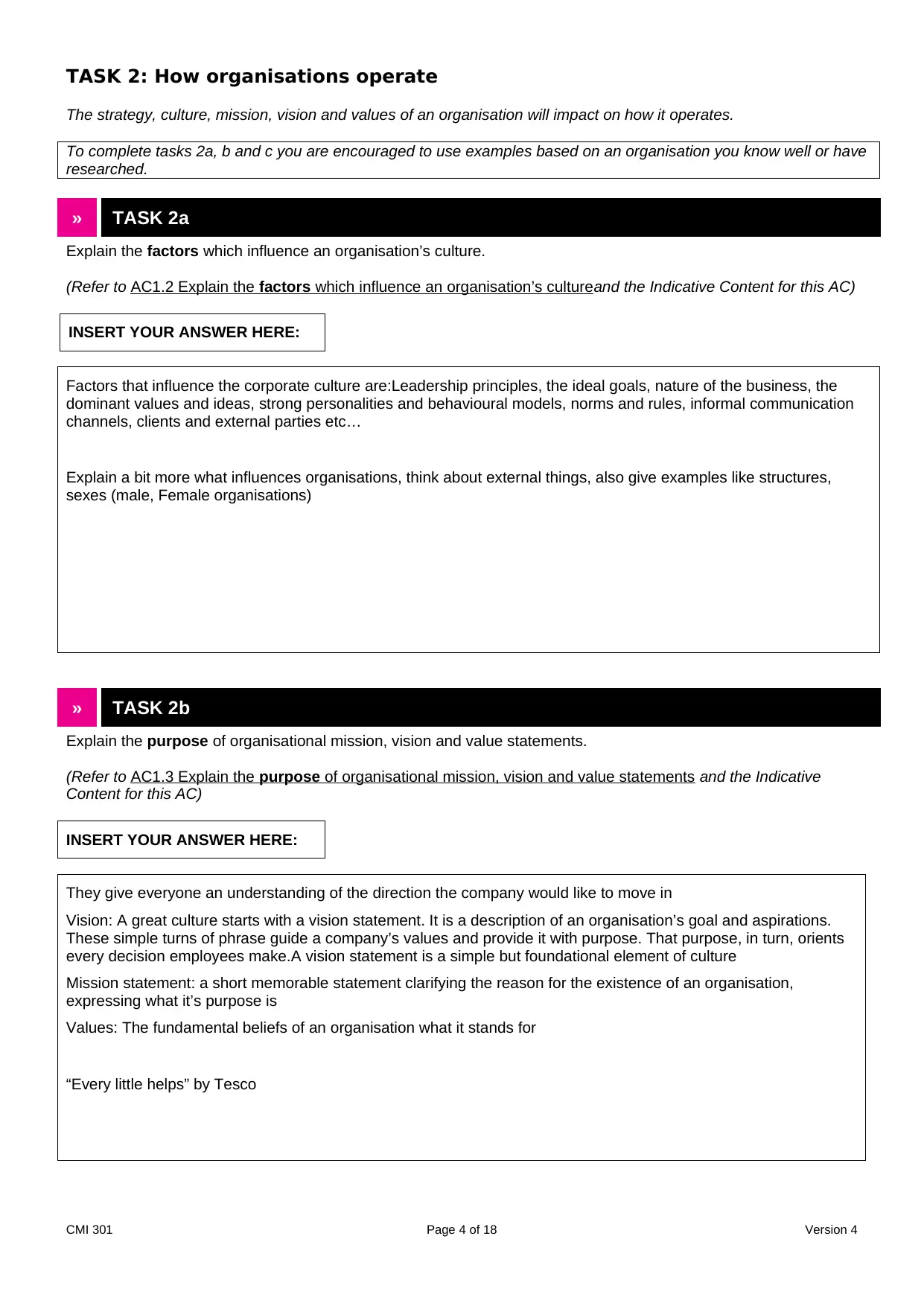
TASK 2: How organisations operate
The strategy, culture, mission, vision and values of an organisation will impact on how it operates.
To complete tasks 2a, b and c you are encouraged to use examples based on an organisation you know well or have
researched.
» TASK 2a
Explain the factors which influence an organisation’s culture.
(Refer to AC1.2 Explain the factors which influence an organisation’s cultureand the Indicative Content for this AC)
INSERT YOUR ANSWER HERE:
Factors that influence the corporate culture are:Leadership principles, the ideal goals, nature of the business, the
dominant values and ideas, strong personalities and behavioural models, norms and rules, informal communication
channels, clients and external parties etc…
Explain a bit more what influences organisations, think about external things, also give examples like structures,
sexes (male, Female organisations)
» TASK 2b
Explain the purpose of organisational mission, vision and value statements.
(Refer to AC1.3 Explain the purpose of organisational mission, vision and value statements and the Indicative
Content for this AC)
INSERT YOUR ANSWER HERE:
They give everyone an understanding of the direction the company would like to move in
Vision: A great culture starts with a vision statement. It is a description of an organisation’s goal and aspirations.
These simple turns of phrase guide a company’s values and provide it with purpose. That purpose, in turn, orients
every decision employees make.A vision statement is a simple but foundational element of culture
Mission statement: a short memorable statement clarifying the reason for the existence of an organisation,
expressing what it’s purpose is
Values: The fundamental beliefs of an organisation what it stands for
“Every little helps” by Tesco
CMI 301 Page 4 of 18 Version 4
The strategy, culture, mission, vision and values of an organisation will impact on how it operates.
To complete tasks 2a, b and c you are encouraged to use examples based on an organisation you know well or have
researched.
» TASK 2a
Explain the factors which influence an organisation’s culture.
(Refer to AC1.2 Explain the factors which influence an organisation’s cultureand the Indicative Content for this AC)
INSERT YOUR ANSWER HERE:
Factors that influence the corporate culture are:Leadership principles, the ideal goals, nature of the business, the
dominant values and ideas, strong personalities and behavioural models, norms and rules, informal communication
channels, clients and external parties etc…
Explain a bit more what influences organisations, think about external things, also give examples like structures,
sexes (male, Female organisations)
» TASK 2b
Explain the purpose of organisational mission, vision and value statements.
(Refer to AC1.3 Explain the purpose of organisational mission, vision and value statements and the Indicative
Content for this AC)
INSERT YOUR ANSWER HERE:
They give everyone an understanding of the direction the company would like to move in
Vision: A great culture starts with a vision statement. It is a description of an organisation’s goal and aspirations.
These simple turns of phrase guide a company’s values and provide it with purpose. That purpose, in turn, orients
every decision employees make.A vision statement is a simple but foundational element of culture
Mission statement: a short memorable statement clarifying the reason for the existence of an organisation,
expressing what it’s purpose is
Values: The fundamental beliefs of an organisation what it stands for
“Every little helps” by Tesco
CMI 301 Page 4 of 18 Version 4
Paraphrase This Document
Need a fresh take? Get an instant paraphrase of this document with our AI Paraphraser
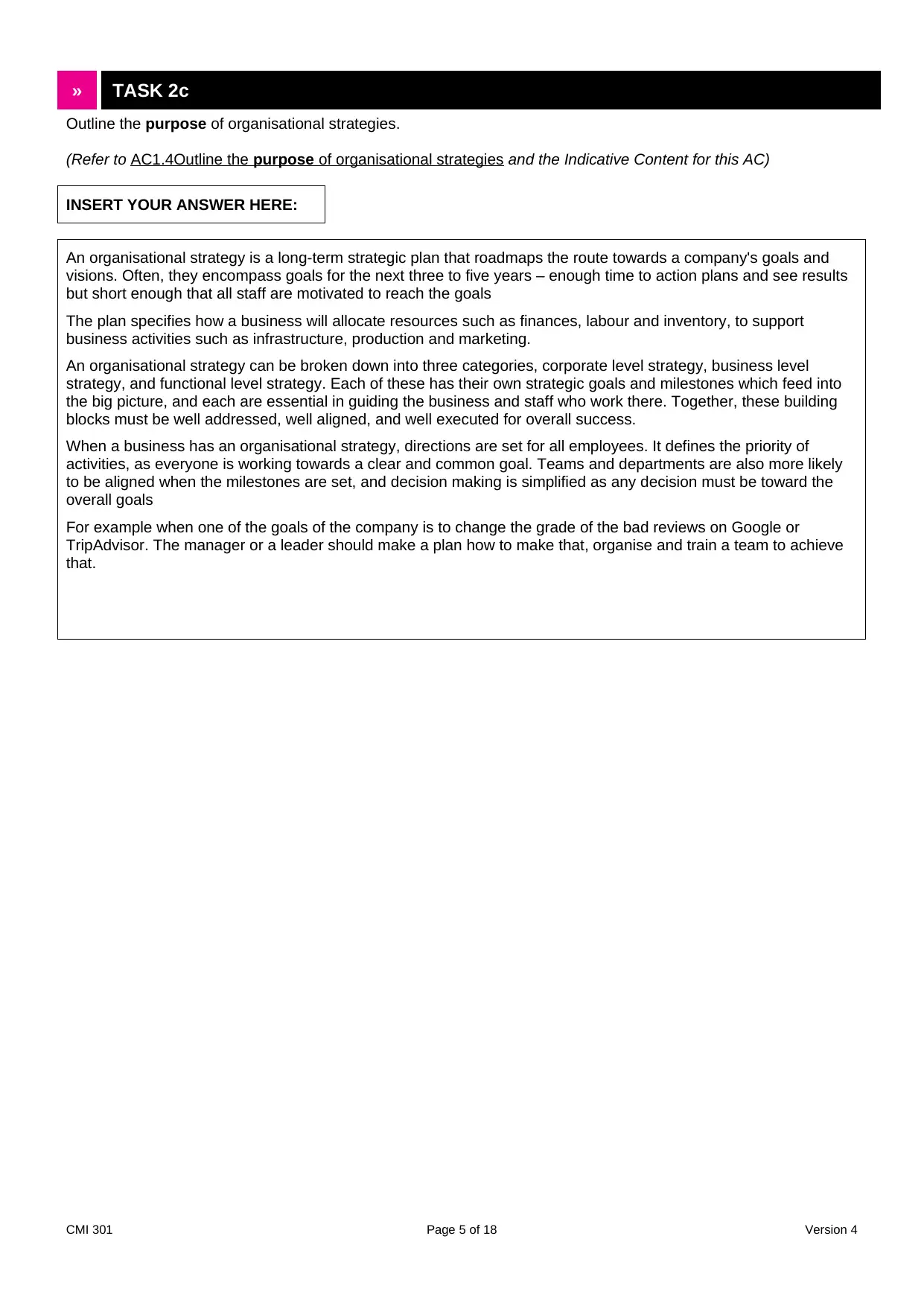
» TASK 2c
Outline the purpose of organisational strategies.
(Refer to AC1.4Outline the purpose of organisational strategies and the Indicative Content for this AC)
INSERT YOUR ANSWER HERE:
An organisational strategy is a long-term strategic plan that roadmaps the route towards a company's goals and
visions. Often, they encompass goals for the next three to five years – enough time to action plans and see results
but short enough that all staff are motivated to reach the goals
The plan specifies how a business will allocate resources such as finances, labour and inventory, to support
business activities such as infrastructure, production and marketing.
An organisational strategy can be broken down into three categories, corporate level strategy, business level
strategy, and functional level strategy. Each of these has their own strategic goals and milestones which feed into
the big picture, and each are essential in guiding the business and staff who work there. Together, these building
blocks must be well addressed, well aligned, and well executed for overall success.
When a business has an organisational strategy, directions are set for all employees. It defines the priority of
activities, as everyone is working towards a clear and common goal. Teams and departments are also more likely
to be aligned when the milestones are set, and decision making is simplified as any decision must be toward the
overall goals
For example when one of the goals of the company is to change the grade of the bad reviews on Google or
TripAdvisor. The manager or a leader should make a plan how to make that, organise and train a team to achieve
that.
CMI 301 Page 5 of 18 Version 4
Outline the purpose of organisational strategies.
(Refer to AC1.4Outline the purpose of organisational strategies and the Indicative Content for this AC)
INSERT YOUR ANSWER HERE:
An organisational strategy is a long-term strategic plan that roadmaps the route towards a company's goals and
visions. Often, they encompass goals for the next three to five years – enough time to action plans and see results
but short enough that all staff are motivated to reach the goals
The plan specifies how a business will allocate resources such as finances, labour and inventory, to support
business activities such as infrastructure, production and marketing.
An organisational strategy can be broken down into three categories, corporate level strategy, business level
strategy, and functional level strategy. Each of these has their own strategic goals and milestones which feed into
the big picture, and each are essential in guiding the business and staff who work there. Together, these building
blocks must be well addressed, well aligned, and well executed for overall success.
When a business has an organisational strategy, directions are set for all employees. It defines the priority of
activities, as everyone is working towards a clear and common goal. Teams and departments are also more likely
to be aligned when the milestones are set, and decision making is simplified as any decision must be toward the
overall goals
For example when one of the goals of the company is to change the grade of the bad reviews on Google or
TripAdvisor. The manager or a leader should make a plan how to make that, organise and train a team to achieve
that.
CMI 301 Page 5 of 18 Version 4
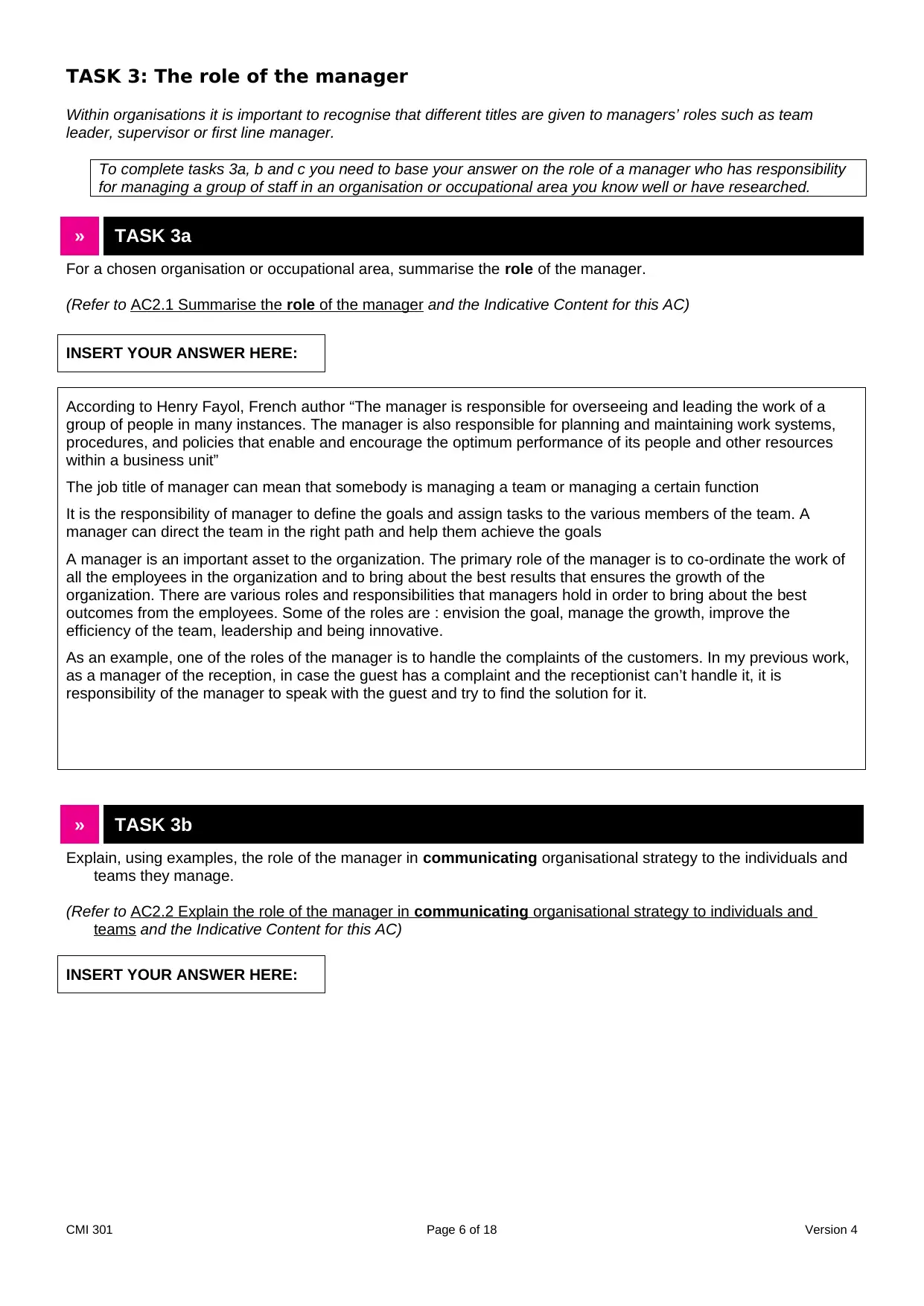
TASK 3: The role of the manager
Within organisations it is important to recognise that different titles are given to managers’ roles such as team
leader, supervisor or first line manager.
To complete tasks 3a, b and c you need to base your answer on the role of a manager who has responsibility
for managing a group of staff in an organisation or occupational area you know well or have researched.
» TASK 3a
For a chosen organisation or occupational area, summarise the role of the manager.
(Refer to AC2.1 Summarise the role of the manager and the Indicative Content for this AC)
INSERT YOUR ANSWER HERE:
According to Henry Fayol, French author “The manager is responsible for overseeing and leading the work of a
group of people in many instances. The manager is also responsible for planning and maintaining work systems,
procedures, and policies that enable and encourage the optimum performance of its people and other resources
within a business unit”
The job title of manager can mean that somebody is managing a team or managing a certain function
It is the responsibility of manager to define the goals and assign tasks to the various members of the team. A
manager can direct the team in the right path and help them achieve the goals
A manager is an important asset to the organization. The primary role of the manager is to co-ordinate the work of
all the employees in the organization and to bring about the best results that ensures the growth of the
organization. There are various roles and responsibilities that managers hold in order to bring about the best
outcomes from the employees. Some of the roles are : envision the goal, manage the growth, improve the
efficiency of the team, leadership and being innovative.
As an example, one of the roles of the manager is to handle the complaints of the customers. In my previous work,
as a manager of the reception, in case the guest has a complaint and the receptionist can’t handle it, it is
responsibility of the manager to speak with the guest and try to find the solution for it.
» TASK 3b
Explain, using examples, the role of the manager in communicating organisational strategy to the individuals and
teams they manage.
(Refer to AC2.2 Explain the role of the manager in communicating organisational strategy to individuals and
teams and the Indicative Content for this AC)
INSERT YOUR ANSWER HERE:
CMI 301 Page 6 of 18 Version 4
Within organisations it is important to recognise that different titles are given to managers’ roles such as team
leader, supervisor or first line manager.
To complete tasks 3a, b and c you need to base your answer on the role of a manager who has responsibility
for managing a group of staff in an organisation or occupational area you know well or have researched.
» TASK 3a
For a chosen organisation or occupational area, summarise the role of the manager.
(Refer to AC2.1 Summarise the role of the manager and the Indicative Content for this AC)
INSERT YOUR ANSWER HERE:
According to Henry Fayol, French author “The manager is responsible for overseeing and leading the work of a
group of people in many instances. The manager is also responsible for planning and maintaining work systems,
procedures, and policies that enable and encourage the optimum performance of its people and other resources
within a business unit”
The job title of manager can mean that somebody is managing a team or managing a certain function
It is the responsibility of manager to define the goals and assign tasks to the various members of the team. A
manager can direct the team in the right path and help them achieve the goals
A manager is an important asset to the organization. The primary role of the manager is to co-ordinate the work of
all the employees in the organization and to bring about the best results that ensures the growth of the
organization. There are various roles and responsibilities that managers hold in order to bring about the best
outcomes from the employees. Some of the roles are : envision the goal, manage the growth, improve the
efficiency of the team, leadership and being innovative.
As an example, one of the roles of the manager is to handle the complaints of the customers. In my previous work,
as a manager of the reception, in case the guest has a complaint and the receptionist can’t handle it, it is
responsibility of the manager to speak with the guest and try to find the solution for it.
» TASK 3b
Explain, using examples, the role of the manager in communicating organisational strategy to the individuals and
teams they manage.
(Refer to AC2.2 Explain the role of the manager in communicating organisational strategy to individuals and
teams and the Indicative Content for this AC)
INSERT YOUR ANSWER HERE:
CMI 301 Page 6 of 18 Version 4
⊘ This is a preview!⊘
Do you want full access?
Subscribe today to unlock all pages.

Trusted by 1+ million students worldwide
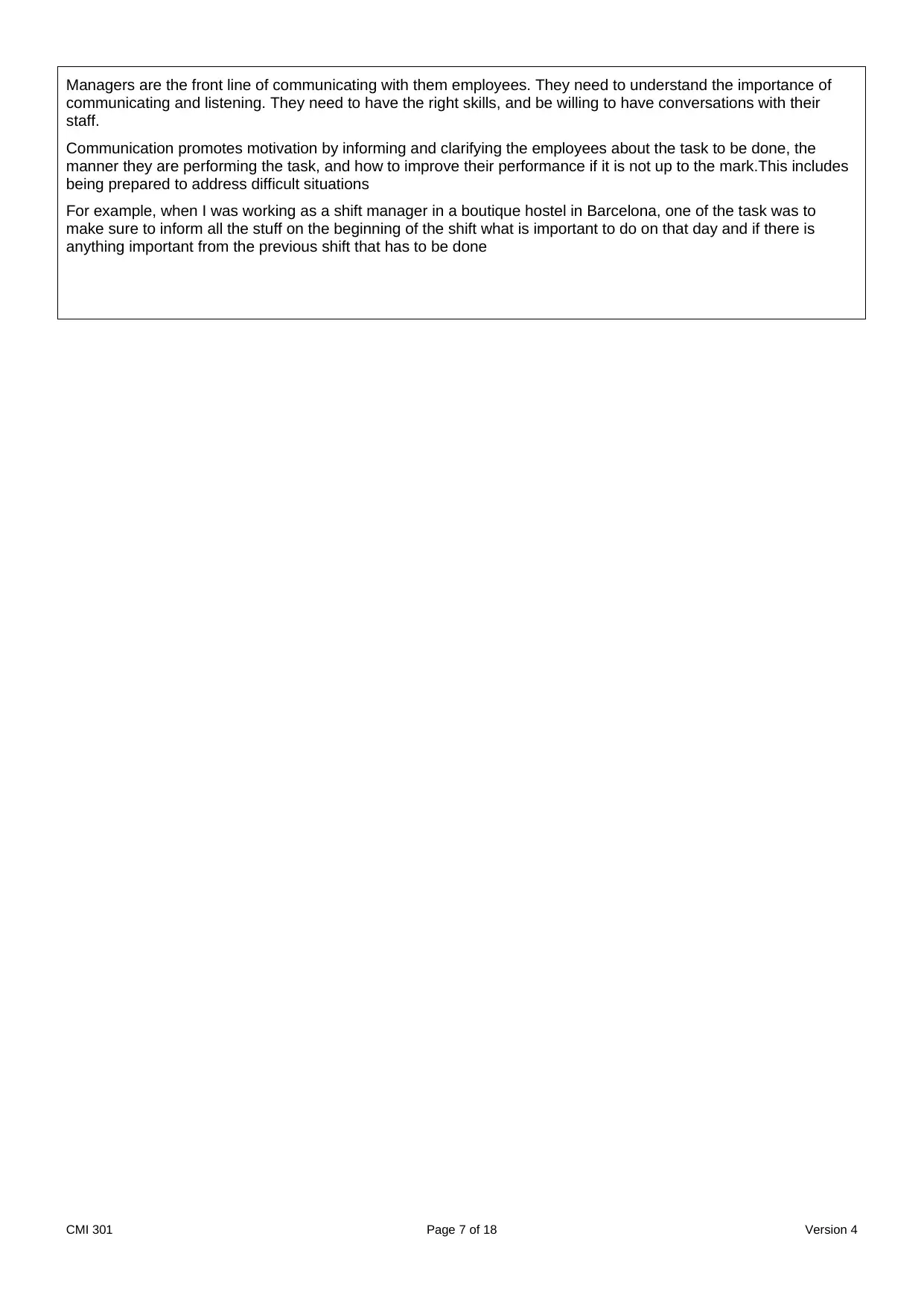
Managers are the front line of communicating with them employees. They need to understand the importance of
communicating and listening. They need to have the right skills, and be willing to have conversations with their
staff.
Communication promotes motivation by informing and clarifying the employees about the task to be done, the
manner they are performing the task, and how to improve their performance if it is not up to the mark.This includes
being prepared to address difficult situations
For example, when I was working as a shift manager in a boutique hostel in Barcelona, one of the task was to
make sure to inform all the stuff on the beginning of the shift what is important to do on that day and if there is
anything important from the previous shift that has to be done
CMI 301 Page 7 of 18 Version 4
communicating and listening. They need to have the right skills, and be willing to have conversations with their
staff.
Communication promotes motivation by informing and clarifying the employees about the task to be done, the
manner they are performing the task, and how to improve their performance if it is not up to the mark.This includes
being prepared to address difficult situations
For example, when I was working as a shift manager in a boutique hostel in Barcelona, one of the task was to
make sure to inform all the stuff on the beginning of the shift what is important to do on that day and if there is
anything important from the previous shift that has to be done
CMI 301 Page 7 of 18 Version 4
Paraphrase This Document
Need a fresh take? Get an instant paraphrase of this document with our AI Paraphraser
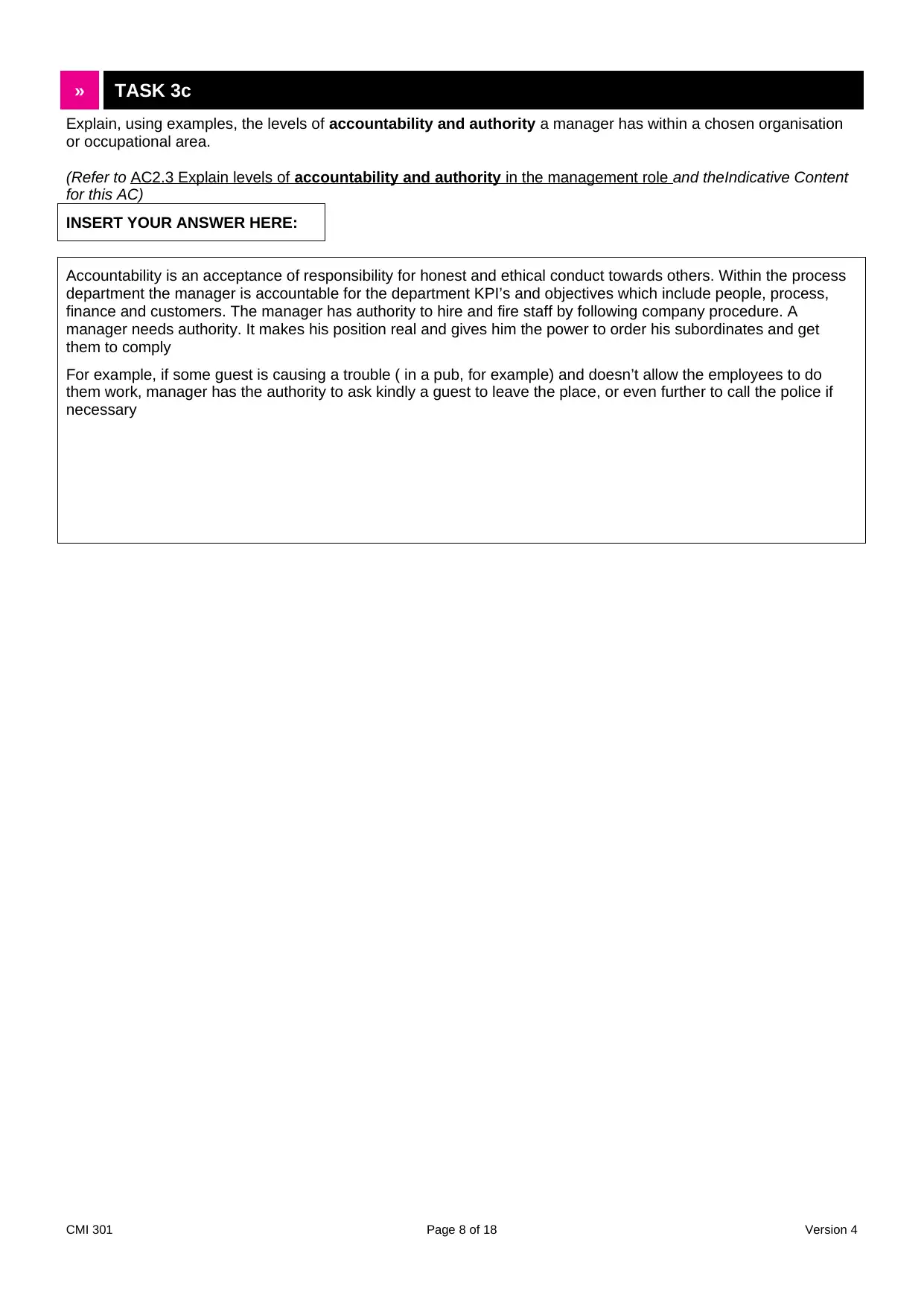
» TASK 3c
Explain, using examples, the levels of accountability and authority a manager has within a chosen organisation
or occupational area.
(Refer to AC2.3 Explain levels of accountability and authority in the management role and theIndicative Content
for this AC)
INSERT YOUR ANSWER HERE:
Accountability is an acceptance of responsibility for honest and ethical conduct towards others. Within the process
department the manager is accountable for the department KPI’s and objectives which include people, process,
finance and customers. The manager has authority to hire and fire staff by following company procedure. A
manager needs authority. It makes his position real and gives him the power to order his subordinates and get
them to comply
For example, if some guest is causing a trouble ( in a pub, for example) and doesn’t allow the employees to do
them work, manager has the authority to ask kindly a guest to leave the place, or even further to call the police if
necessary
CMI 301 Page 8 of 18 Version 4
Explain, using examples, the levels of accountability and authority a manager has within a chosen organisation
or occupational area.
(Refer to AC2.3 Explain levels of accountability and authority in the management role and theIndicative Content
for this AC)
INSERT YOUR ANSWER HERE:
Accountability is an acceptance of responsibility for honest and ethical conduct towards others. Within the process
department the manager is accountable for the department KPI’s and objectives which include people, process,
finance and customers. The manager has authority to hire and fire staff by following company procedure. A
manager needs authority. It makes his position real and gives him the power to order his subordinates and get
them to comply
For example, if some guest is causing a trouble ( in a pub, for example) and doesn’t allow the employees to do
them work, manager has the authority to ask kindly a guest to leave the place, or even further to call the police if
necessary
CMI 301 Page 8 of 18 Version 4
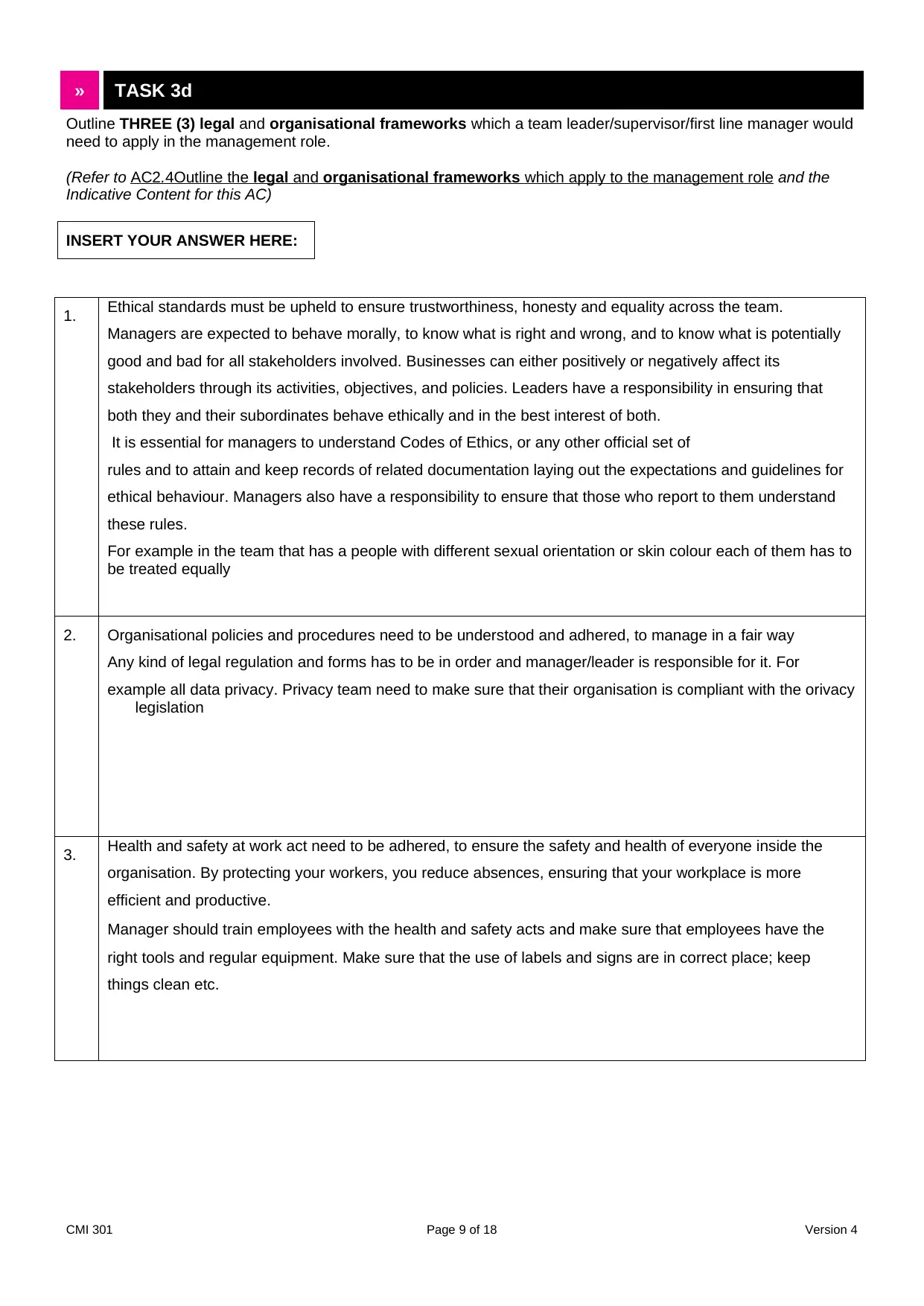
» TASK 3d
Outline THREE (3) legal and organisational frameworks which a team leader/supervisor/first line manager would
need to apply in the management role.
(Refer to AC2.4Outline the legal and organisational frameworks which apply to the management role and the
Indicative Content for this AC)
INSERT YOUR ANSWER HERE:
1. Ethical standards must be upheld to ensure trustworthiness, honesty and equality across the team.
Managers are expected to behave morally, to know what is right and wrong, and to know what is potentially
good and bad for all stakeholders involved. Businesses can either positively or negatively affect its
stakeholders through its activities, objectives, and policies. Leaders have a responsibility in ensuring that
both they and their subordinates behave ethically and in the best interest of both.
It is essential for managers to understand Codes of Ethics, or any other official set of
rules and to attain and keep records of related documentation laying out the expectations and guidelines for
ethical behaviour. Managers also have a responsibility to ensure that those who report to them understand
these rules.
For example in the team that has a people with different sexual orientation or skin colour each of them has to
be treated equally
2. Organisational policies and procedures need to be understood and adhered, to manage in a fair way
Any kind of legal regulation and forms has to be in order and manager/leader is responsible for it. For
example all data privacy. Privacy team need to make sure that their organisation is compliant with the orivacy
legislation
3. Health and safety at work act need to be adhered, to ensure the safety and health of everyone inside the
organisation. By protecting your workers, you reduce absences, ensuring that your workplace is more
efficient and productive.
Manager should train employees with the health and safety acts and make sure that employees have the
right tools and regular equipment. Make sure that the use of labels and signs are in correct place; keep
things clean etc.
CMI 301 Page 9 of 18 Version 4
Outline THREE (3) legal and organisational frameworks which a team leader/supervisor/first line manager would
need to apply in the management role.
(Refer to AC2.4Outline the legal and organisational frameworks which apply to the management role and the
Indicative Content for this AC)
INSERT YOUR ANSWER HERE:
1. Ethical standards must be upheld to ensure trustworthiness, honesty and equality across the team.
Managers are expected to behave morally, to know what is right and wrong, and to know what is potentially
good and bad for all stakeholders involved. Businesses can either positively or negatively affect its
stakeholders through its activities, objectives, and policies. Leaders have a responsibility in ensuring that
both they and their subordinates behave ethically and in the best interest of both.
It is essential for managers to understand Codes of Ethics, or any other official set of
rules and to attain and keep records of related documentation laying out the expectations and guidelines for
ethical behaviour. Managers also have a responsibility to ensure that those who report to them understand
these rules.
For example in the team that has a people with different sexual orientation or skin colour each of them has to
be treated equally
2. Organisational policies and procedures need to be understood and adhered, to manage in a fair way
Any kind of legal regulation and forms has to be in order and manager/leader is responsible for it. For
example all data privacy. Privacy team need to make sure that their organisation is compliant with the orivacy
legislation
3. Health and safety at work act need to be adhered, to ensure the safety and health of everyone inside the
organisation. By protecting your workers, you reduce absences, ensuring that your workplace is more
efficient and productive.
Manager should train employees with the health and safety acts and make sure that employees have the
right tools and regular equipment. Make sure that the use of labels and signs are in correct place; keep
things clean etc.
CMI 301 Page 9 of 18 Version 4
⊘ This is a preview!⊘
Do you want full access?
Subscribe today to unlock all pages.

Trusted by 1+ million students worldwide
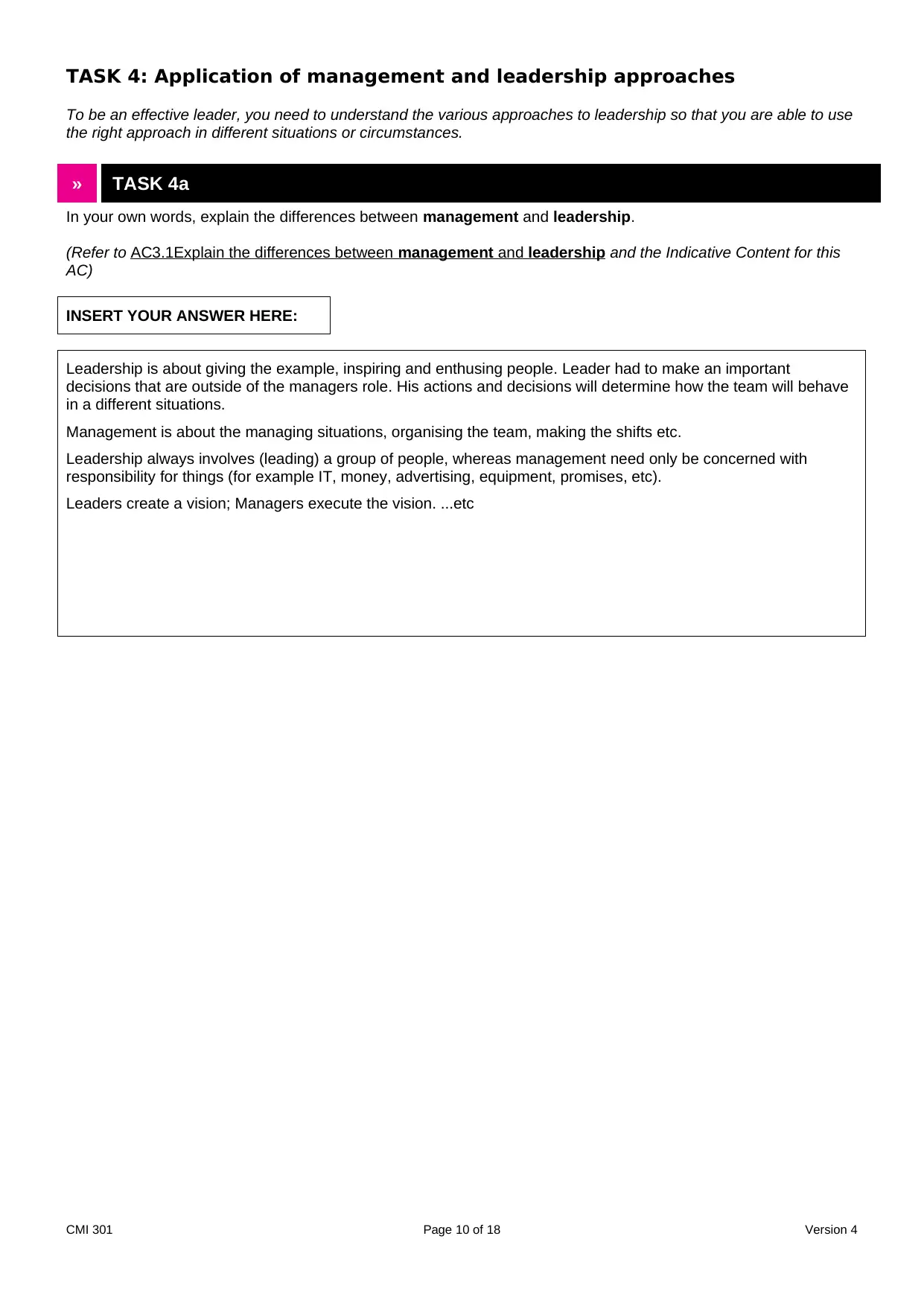
TASK 4: Application of management and leadership approaches
To be an effective leader, you need to understand the various approaches to leadership so that you are able to use
the right approach in different situations or circumstances.
» TASK 4a
In your own words, explain the differences between management and leadership.
(Refer to AC3.1Explain the differences between management and leadership and the Indicative Content for this
AC)
INSERT YOUR ANSWER HERE:
Leadership is about giving the example, inspiring and enthusing people. Leader had to make an important
decisions that are outside of the managers role. His actions and decisions will determine how the team will behave
in a different situations.
Management is about the managing situations, organising the team, making the shifts etc.
Leadership always involves (leading) a group of people, whereas management need only be concerned with
responsibility for things (for example IT, money, advertising, equipment, promises, etc).
Leaders create a vision; Managers execute the vision. ...etc
CMI 301 Page 10 of 18 Version 4
To be an effective leader, you need to understand the various approaches to leadership so that you are able to use
the right approach in different situations or circumstances.
» TASK 4a
In your own words, explain the differences between management and leadership.
(Refer to AC3.1Explain the differences between management and leadership and the Indicative Content for this
AC)
INSERT YOUR ANSWER HERE:
Leadership is about giving the example, inspiring and enthusing people. Leader had to make an important
decisions that are outside of the managers role. His actions and decisions will determine how the team will behave
in a different situations.
Management is about the managing situations, organising the team, making the shifts etc.
Leadership always involves (leading) a group of people, whereas management need only be concerned with
responsibility for things (for example IT, money, advertising, equipment, promises, etc).
Leaders create a vision; Managers execute the vision. ...etc
CMI 301 Page 10 of 18 Version 4
Paraphrase This Document
Need a fresh take? Get an instant paraphrase of this document with our AI Paraphraser
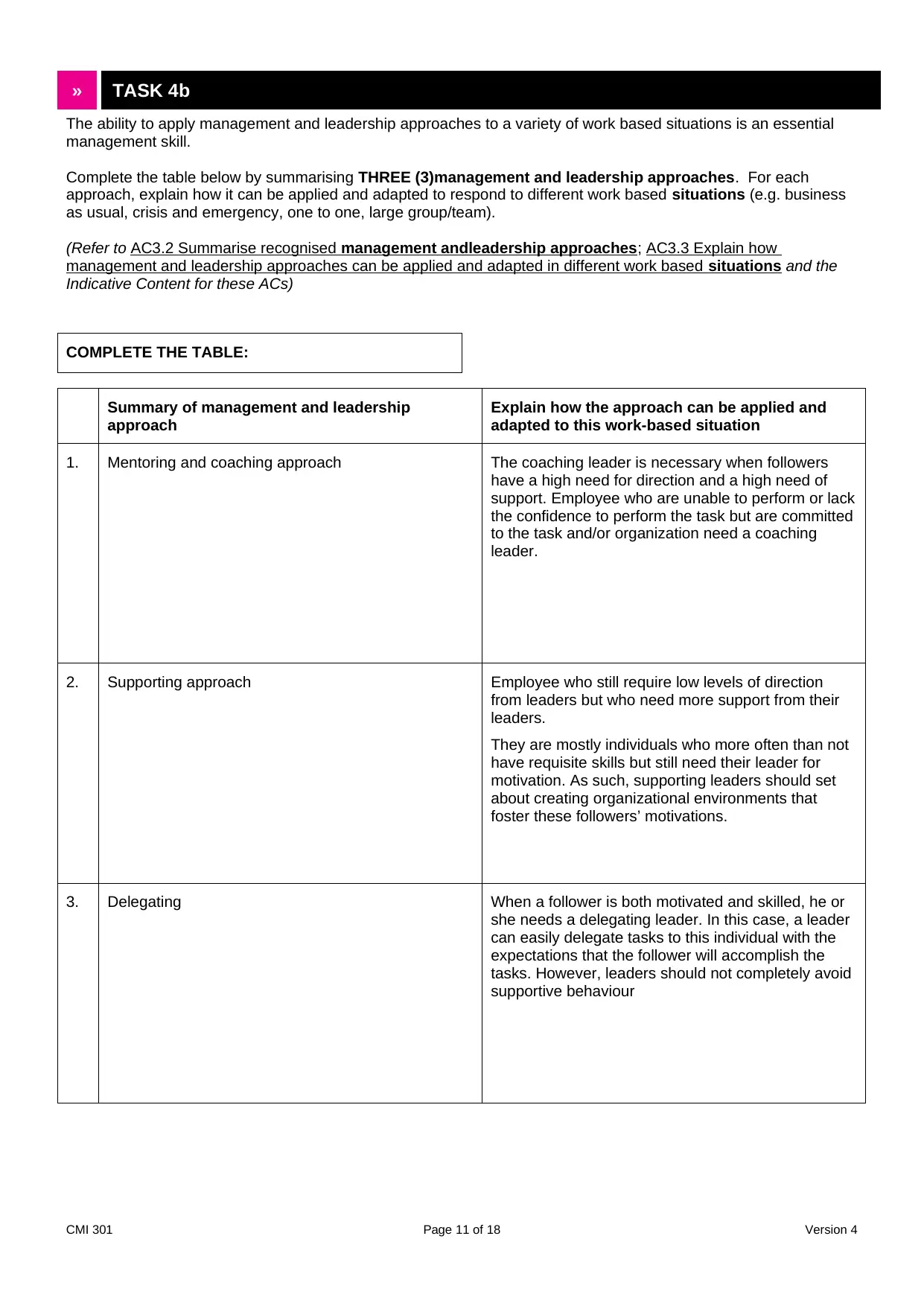
» TASK 4b
The ability to apply management and leadership approaches to a variety of work based situations is an essential
management skill.
Complete the table below by summarising THREE (3)management and leadership approaches. For each
approach, explain how it can be applied and adapted to respond to different work based situations (e.g. business
as usual, crisis and emergency, one to one, large group/team).
(Refer to AC3.2 Summarise recognised management andleadership approaches; AC3.3 Explain how
management and leadership approaches can be applied and adapted in different work based situations and the
Indicative Content for these ACs)
COMPLETE THE TABLE:
Summary of management and leadership
approach
Explain how the approach can be applied and
adapted to this work-based situation
1. Mentoring and coaching approach The coaching leader is necessary when followers
have a high need for direction and a high need of
support. Employee who are unable to perform or lack
the confidence to perform the task but are committed
to the task and/or organization need a coaching
leader.
2. Supporting approach Employee who still require low levels of direction
from leaders but who need more support from their
leaders.
They are mostly individuals who more often than not
have requisite skills but still need their leader for
motivation. As such, supporting leaders should set
about creating organizational environments that
foster these followers’ motivations.
3. Delegating When a follower is both motivated and skilled, he or
she needs a delegating leader. In this case, a leader
can easily delegate tasks to this individual with the
expectations that the follower will accomplish the
tasks. However, leaders should not completely avoid
supportive behaviour
CMI 301 Page 11 of 18 Version 4
The ability to apply management and leadership approaches to a variety of work based situations is an essential
management skill.
Complete the table below by summarising THREE (3)management and leadership approaches. For each
approach, explain how it can be applied and adapted to respond to different work based situations (e.g. business
as usual, crisis and emergency, one to one, large group/team).
(Refer to AC3.2 Summarise recognised management andleadership approaches; AC3.3 Explain how
management and leadership approaches can be applied and adapted in different work based situations and the
Indicative Content for these ACs)
COMPLETE THE TABLE:
Summary of management and leadership
approach
Explain how the approach can be applied and
adapted to this work-based situation
1. Mentoring and coaching approach The coaching leader is necessary when followers
have a high need for direction and a high need of
support. Employee who are unable to perform or lack
the confidence to perform the task but are committed
to the task and/or organization need a coaching
leader.
2. Supporting approach Employee who still require low levels of direction
from leaders but who need more support from their
leaders.
They are mostly individuals who more often than not
have requisite skills but still need their leader for
motivation. As such, supporting leaders should set
about creating organizational environments that
foster these followers’ motivations.
3. Delegating When a follower is both motivated and skilled, he or
she needs a delegating leader. In this case, a leader
can easily delegate tasks to this individual with the
expectations that the follower will accomplish the
tasks. However, leaders should not completely avoid
supportive behaviour
CMI 301 Page 11 of 18 Version 4
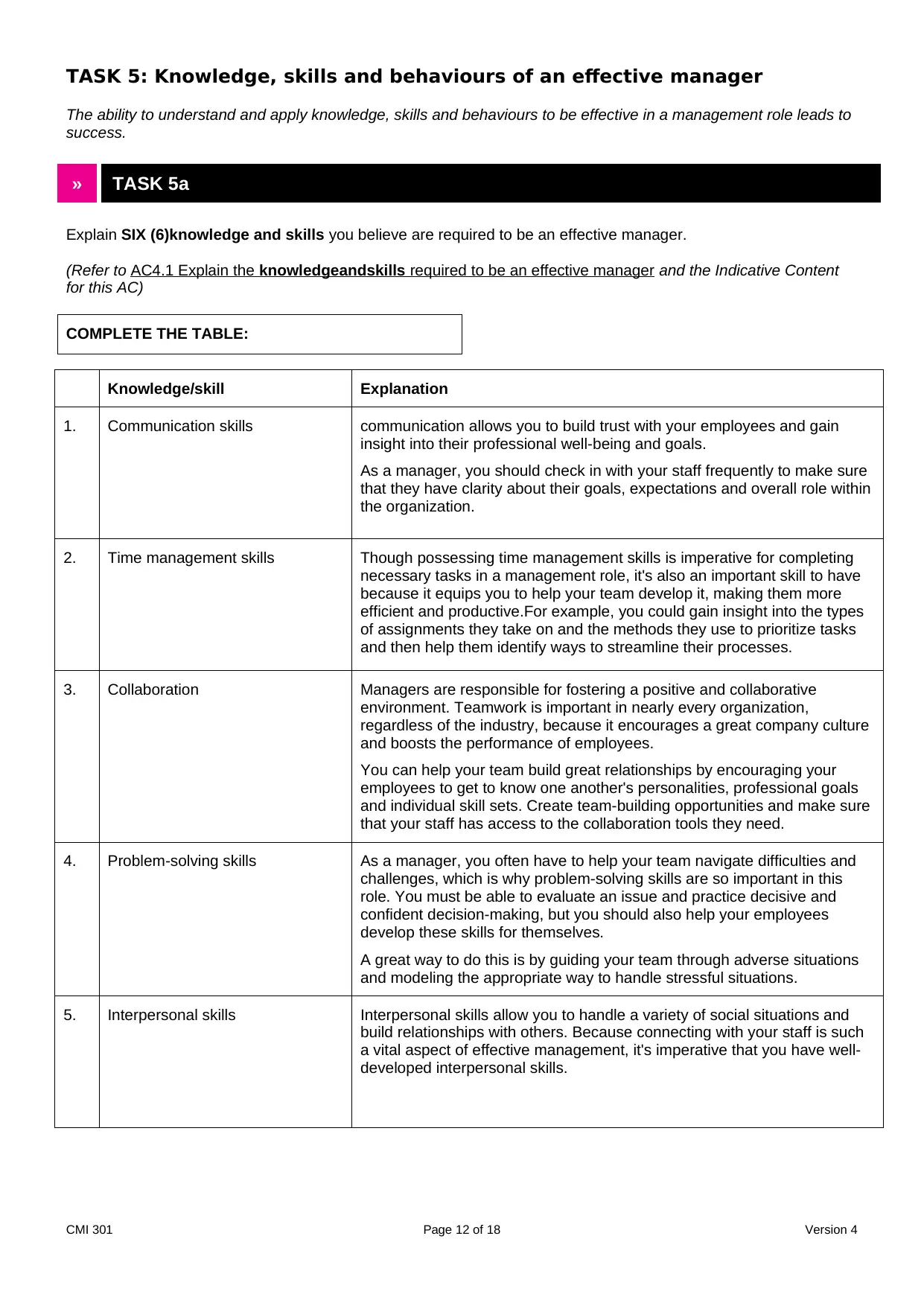
TASK 5: Knowledge, skills and behaviours of an effective manager
The ability to understand and apply knowledge, skills and behaviours to be effective in a management role leads to
success.
» TASK 5a
Explain SIX (6)knowledge and skills you believe are required to be an effective manager.
(Refer to AC4.1 Explain the knowledgeandskills required to be an effective manager and the Indicative Content
for this AC)
COMPLETE THE TABLE:
Knowledge/skill Explanation
1. Communication skills communication allows you to build trust with your employees and gain
insight into their professional well-being and goals.
As a manager, you should check in with your staff frequently to make sure
that they have clarity about their goals, expectations and overall role within
the organization.
2. Time management skills Though possessing time management skills is imperative for completing
necessary tasks in a management role, it's also an important skill to have
because it equips you to help your team develop it, making them more
efficient and productive.For example, you could gain insight into the types
of assignments they take on and the methods they use to prioritize tasks
and then help them identify ways to streamline their processes.
3. Collaboration Managers are responsible for fostering a positive and collaborative
environment. Teamwork is important in nearly every organization,
regardless of the industry, because it encourages a great company culture
and boosts the performance of employees.
You can help your team build great relationships by encouraging your
employees to get to know one another's personalities, professional goals
and individual skill sets. Create team-building opportunities and make sure
that your staff has access to the collaboration tools they need.
4. Problem-solving skills As a manager, you often have to help your team navigate difficulties and
challenges, which is why problem-solving skills are so important in this
role. You must be able to evaluate an issue and practice decisive and
confident decision-making, but you should also help your employees
develop these skills for themselves.
A great way to do this is by guiding your team through adverse situations
and modeling the appropriate way to handle stressful situations.
5. Interpersonal skills Interpersonal skills allow you to handle a variety of social situations and
build relationships with others. Because connecting with your staff is such
a vital aspect of effective management, it's imperative that you have well-
developed interpersonal skills.
CMI 301 Page 12 of 18 Version 4
The ability to understand and apply knowledge, skills and behaviours to be effective in a management role leads to
success.
» TASK 5a
Explain SIX (6)knowledge and skills you believe are required to be an effective manager.
(Refer to AC4.1 Explain the knowledgeandskills required to be an effective manager and the Indicative Content
for this AC)
COMPLETE THE TABLE:
Knowledge/skill Explanation
1. Communication skills communication allows you to build trust with your employees and gain
insight into their professional well-being and goals.
As a manager, you should check in with your staff frequently to make sure
that they have clarity about their goals, expectations and overall role within
the organization.
2. Time management skills Though possessing time management skills is imperative for completing
necessary tasks in a management role, it's also an important skill to have
because it equips you to help your team develop it, making them more
efficient and productive.For example, you could gain insight into the types
of assignments they take on and the methods they use to prioritize tasks
and then help them identify ways to streamline their processes.
3. Collaboration Managers are responsible for fostering a positive and collaborative
environment. Teamwork is important in nearly every organization,
regardless of the industry, because it encourages a great company culture
and boosts the performance of employees.
You can help your team build great relationships by encouraging your
employees to get to know one another's personalities, professional goals
and individual skill sets. Create team-building opportunities and make sure
that your staff has access to the collaboration tools they need.
4. Problem-solving skills As a manager, you often have to help your team navigate difficulties and
challenges, which is why problem-solving skills are so important in this
role. You must be able to evaluate an issue and practice decisive and
confident decision-making, but you should also help your employees
develop these skills for themselves.
A great way to do this is by guiding your team through adverse situations
and modeling the appropriate way to handle stressful situations.
5. Interpersonal skills Interpersonal skills allow you to handle a variety of social situations and
build relationships with others. Because connecting with your staff is such
a vital aspect of effective management, it's imperative that you have well-
developed interpersonal skills.
CMI 301 Page 12 of 18 Version 4
⊘ This is a preview!⊘
Do you want full access?
Subscribe today to unlock all pages.

Trusted by 1+ million students worldwide
1 out of 18
Related Documents
Your All-in-One AI-Powered Toolkit for Academic Success.
+13062052269
info@desklib.com
Available 24*7 on WhatsApp / Email
![[object Object]](/_next/static/media/star-bottom.7253800d.svg)
Unlock your academic potential
Copyright © 2020–2025 A2Z Services. All Rights Reserved. Developed and managed by ZUCOL.





